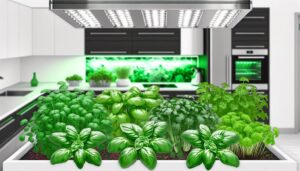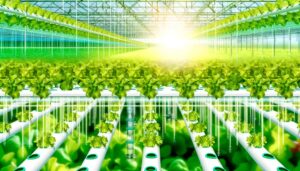What Is the Difference Between Hydroponic and Aeroponic
We distinguish hydroponic and aeroponic systems primarily by their methods of nutrient delivery and root exposure. In hydroponics, plants' roots are submerged in nutrient-rich water, optimizing growth and minimizing soil-borne diseases.
It's simpler to set up and maintain, making it accessible for beginners. Aeroponics involves misting roots with nutrient solutions, maximizing oxygen exposure and promoting rapid growth.
It uses less water and offers minimal disease risk but requires more sophisticated equipment. Both systems excel in water efficiency and space utilization, yet they cater to different operational needs.
Understanding these distinctions can help us make more informed choices.

Key Takeaways
- Hydroponics involves roots submerged in nutrient-rich water; aeroponics suspends roots in air and periodically mists them with nutrients.
- Aeroponics provides superior oxygen exposure, enhancing growth rates, while hydroponics offers direct nutrient access through continuous water flow.
- Hydroponic systems are generally simpler to set up and maintain compared to the more complex aeroponic systems.
- Aeroponics uses less water than hydroponics, making it more water-efficient and environmentally sustainable.
How Hydroponic Systems Work

Hydroponic systems operate by delivering nutrient-rich water directly to plant roots, bypassing the need for soil.
These systems come in various configurations, such as nutrient film technique (NFT), deep water culture (DWC), and ebb and flow.
We find that hydroponics provide a controlled environment, optimizing growth conditions and reducing the risk of soil-borne diseases.
Studies show that plants grown hydroponically can achieve faster growth rates and higher yields compared to traditional soil cultivation.
Key components include grow lights, pumps, and reservoirs, which guarantee consistent nutrient delivery.
How Aeroponic Systems Work
Let's examine how aeroponic systems function.
We employ a fine mist to deliver nutrients directly to the roots, ensuring efficient absorption.
This method maximizes root exposure to oxygen, promoting rapid growth and higher yields.
Nutrient Delivery Method
Aeroponic systems deliver nutrients by misting the plant roots with a nutrient-rich solution, ensuring efficient absorption and oxygenation. This method involves using high-pressure nozzles to create a fine mist, which directly contacts the root surface.
We observe several key benefits from this approach:
- Enhanced oxygenation: The roots are consistently exposed to air, promoting vigorous growth.
- Efficient nutrient uptake: The fine mist allows for ideal absorption of nutrients.
- Reduced water usage: Misting conserves water compared to traditional soil-based methods.
Root Exposure Techniques
Understanding the intricacies of root exposure techniques is fundamental to appreciating how aeroponic systems enhance plant growth.
In these systems, we suspend plant roots in air, allowing them to receive maximum oxygenation. Nutrient-rich water mist is periodically sprayed directly onto the roots, ensuring they get essential nutrients without soil.
This method minimizes water usage, as the mist delivers nutrients efficiently. Additionally, the high oxygen exposure promotes accelerated growth and enhances nutrient uptake.
We monitor and control the misting intervals and nutrient concentrations to maintain ideal conditions. By eliminating the medium, we reduce the risk of soil-borne diseases and pests.
This precise and controlled environment fosters innovation in sustainable agriculture, leading to healthier and faster-growing plants.
Key Differences Explained

Hydroponic and aeroponic systems differ primarily in their methods of delivering nutrients to plant roots. In hydroponics, plants grow with their roots submerged in a nutrient-rich water solution. In contrast, aeroponics involves suspending roots in the air and misting them with a nutrient solution.
Nutrient delivery: Hydroponics uses a continuous flow or standing water, while aeroponics relies on periodic misting.
Root environment: Hydroponic roots are constantly in a water-nutrient solution; aeroponic roots are exposed to air.
Setup complexity: Aeroponic systems often require more sophisticated equipment and precise control mechanisms.
Oxygen availability: Aeroponics provides superior oxygen exposure to roots, promoting faster growth rates.
Benefits of Hydroponic Systems
As we explore the benefits of hydroponic systems, we should focus on water efficiency, faster plant growth, and ideal space utilization.
Studies show that hydroponics use up to 90% less water compared to traditional soil-based methods.
Additionally, plants grow up to 50% faster and the vertical setup maximizes space, making it perfect for urban environments.
Water Efficiency
With respect to water efficiency, hydroponic systems dramatically reduce water usage by recycling and reusing nutrient solutions. By employing closed-loop systems, we guarantee that minimal water is wasted. This efficiency is vital for sustainable agriculture, particularly in regions facing water scarcity.
Let's consider the following benefits:
- Reduced Evaporation: Water doesn't evaporate as quickly in a controlled environment.
- Precision Irrigation: We deliver exact amounts of water directly to plant roots, avoiding overuse.
- Less Runoff: Closed systems eliminate water runoff, preventing nutrient loss and contamination.
This objective analysis highlights hydroponic systems' capacity to innovate water use in agriculture.
Faster Plant Growth
Beyond water efficiency, we also see significant advantages in plant growth speed when utilizing hydroponic systems. By providing direct access to nutrients and oxygen, plants often grow up to 50% faster than those in soil. The controlled environment eliminates variables that typically slow growth, such as nutrient deficiencies and pest interference. Here's a comparison between soil-based and hydroponic growth rates:
| Aspect | Soil-Based Growth | Hydroponic Growth |
|---|---|---|
| Growth Speed | Moderate | Fast |
| Nutrient Access | Variable | Direct |
| Pest Exposure | High | Low |
| Water Usage | High | Low |
| Yield | Lower | Higher |
This acceleration is particularly beneficial for high-demand crops, allowing for more frequent harvests and increased productivity. By optimizing these factors, we're making strides toward more efficient and sustainable agricultural practices.
Space Utilization
Leveraging vertical farming techniques, hydroponic systems maximize space efficiency, enabling more plants to be grown per square foot than traditional soil-based methods.
This innovative approach facilitates higher yields in confined spaces, making it ideal for urban settings and locations with limited arable land. We can optimize plant density without sacrificing growth quality or accessibility.
Key advantages include:
- Stacked layers of crops: Multiple tiers allow for efficient use of vertical space.
- Compact system designs: Modular setups fit into smaller spaces, enhancing adaptability.
- Optimized light distribution: LED grow lights guarantee all plants receive adequate illumination.
Benefits of Aeroponic Systems

Aeroponic systems offer the unique advantage of using up to 95% less water compared to traditional soil-based methods. This efficiency is essential as global water resources become increasingly strained.
Additionally, aeroponic systems can achieve faster plant growth rates due to enhanced oxygenation of the root zone, which improves nutrient uptake. By eliminating soil, we also reduce the risk of soil-borne diseases and pests, leading to healthier plants.
Furthermore, the precision control in aeroponics allows for tailored nutrient delivery, ensuring plants receive exactly what they need for ideal growth. As a result, we can achieve higher yields per square foot.
This makes aeroponic systems highly suitable for urban farming and vertical gardens, aligning perfectly with our quest for innovative agricultural solutions.
Choosing the Right System
When choosing the right system for your needs, it's crucial to take into account factors such as water efficiency, growth rates, and space utilization.
Hydroponic systems provide a more straightforward setup and are generally easier to maintain. However, aeroponic systems offer superior oxygenation, leading to faster growth rates and potentially higher yields.
To help you visualize the differences:
- Water Efficiency: Aeroponics uses up to 90% less water.
- Growth Rates: Aeroponics can increase growth rates by up to 30%.
- Space Utilization: Vertical farming is easier with aeroponics.
Conclusion
In choosing between hydroponic and aeroponic systems, we must weigh the specific benefits each offers.
Hydroponics is simpler and more established, while aeroponics provides superior oxygenation and nutrient delivery.
Which system aligns with our goals for efficiency and yield?
By understanding the mechanics and advantages of both methods, we can make an informed decision that maximizes growth potential and resource use.
Ultimately, our choice will reflect our unique needs and cultivation objectives.






